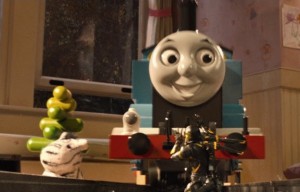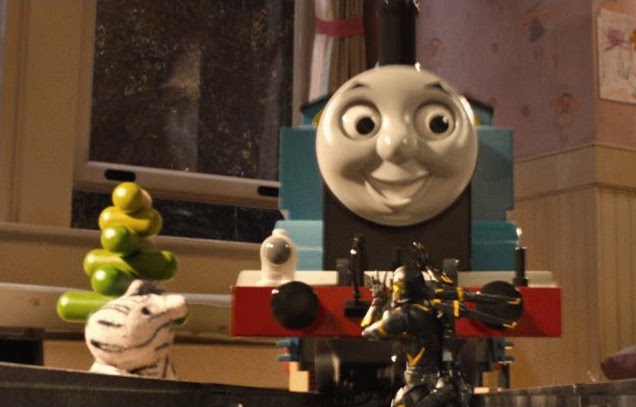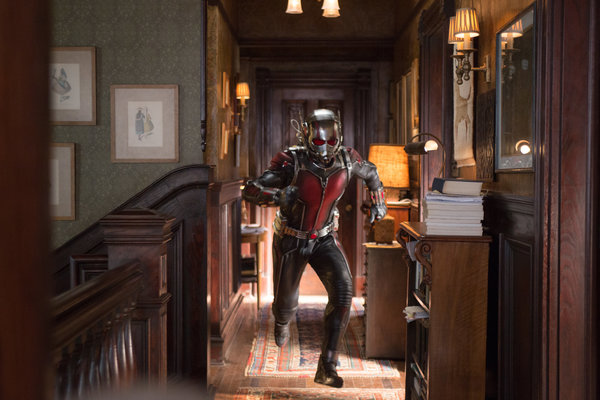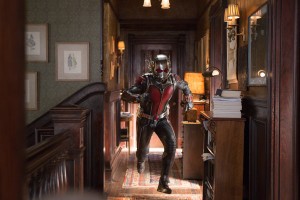Interview: Trevor Habberstad on the Stunts in “Ant-Man”
Posted on December 10, 2015 at 8:00 am
Trevor Habberstad, a second generation stuntman, coordinated the stunts for the Marvel movie, Ant-Man. In an interview, we talked about the special challenges of creating stunts for a superhero who is only a fraction of an inch high. “We had a lot of time during pre-production to work on it. We had three months of stunt preps, and daily meetings with Peyton , our director, with Paul , even with the Marvel executives Kevin Fiege and Victoria Alonso and all of them, talking about what his limitations were and we’d say, ‘Okay, well this works, that doesn’t. That seems like it could be feasible. Let’s see if we could come up with something cool where that could play into script and into the story.’ And then maybe we would think of something that we thought was maybe really cool and then we got into it and started rehearsing the stunts and it just may not have worked. So it’s a lot of collaborating with each other and sort of figuring out what we liked, what was fun, what was exciting, what was believable, but still made the superhero a superhero.”
He is small, but he has the same power he had at full-size. The question was not how to make the stunts obey the laws of physics but how to make them seem like they do. “Okay, if he is half an inch tall but he is normally a 6 foot tall guy, 180 pounds, you take all that power and energy into that small person, so as he shrinking down, is he dense? What would happen if he gets hit? Is he really heavy when he’s that way? No because you want him to run alongside people and they would notice if he is there and he still felt like 180 pounds just crammed into half an inch. Okay so that doesn’t work, so you know what, he is a superhero so we’re just going to go with that and that’s going to be our explanation for that one. He is small but he is still really strong. Most of what we were able to come up with a logical as far as a superhero movie goes. He could punch someone but he has to be careful because with the force of my fist hitting something if I took that same amount of energy and pass it into a fist that size then I can really hurt somebody with a punch. So a part of the movie is where he trains, he learns from Hope Dyne how to properly fight so he doesn’t kill people but he can still be strong and destructive and be Ant-Man.”

 A highlight of the film is the fight on a train which is very intense — and then it turns out to be a child’s Thomas the Tanks engine toy train set. “We did all the movements with motion capture, so we had our stunt doubles, actors in motion capture suits on a sound stage and we were capturing all their movements with a bunch of cameras all over the place and they have these suits that look like pajamas with a bunch of shiny balls all over them, tracking every little movement. And then we would recreate the scene step-by-step. Our group would build a little set piece to mockup, ‘Okay this is going to be the train, and this is the engine, this is the caboose, is going to be standing here, he is standing over here.’ We were able to play pretend like you would when you are kid just on a really, really large Marvel-size scale.” One of the stunts that came out of this process was the idea that Ant-Man would run toward a door full-size, then shrink down to jump through the keyhole, and then be full-size again on the other side of the door. “That’s the awesome part for us; we get to help influence the story.”
A highlight of the film is the fight on a train which is very intense — and then it turns out to be a child’s Thomas the Tanks engine toy train set. “We did all the movements with motion capture, so we had our stunt doubles, actors in motion capture suits on a sound stage and we were capturing all their movements with a bunch of cameras all over the place and they have these suits that look like pajamas with a bunch of shiny balls all over them, tracking every little movement. And then we would recreate the scene step-by-step. Our group would build a little set piece to mockup, ‘Okay this is going to be the train, and this is the engine, this is the caboose, is going to be standing here, he is standing over here.’ We were able to play pretend like you would when you are kid just on a really, really large Marvel-size scale.” One of the stunts that came out of this process was the idea that Ant-Man would run toward a door full-size, then shrink down to jump through the keyhole, and then be full-size again on the other side of the door. “That’s the awesome part for us; we get to help influence the story.”
Habberstad’s father is a stuntman, and so his first stunt job was riding a horse in the Andy Garcia film, Steal Big, Steal Little when he was just five years old.
He can do “anything movement-based, but in general I think my best skill is that I have a very diverse set of skills. I can do a little of everything and that make me more versatile, makes me more valuable to a production.” The best advice he ever got about stunts is equally applicable to any endeavor: “Shut up and watch and ask questions if you don’t know what something is. Ask because you’ve got to know what you don’t know.”




